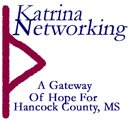Aspen Institute Assessment of FEMA
New Report Highlights Role of Grassroots Nonprofits in Disaster Relief
Washington, DC, June 19, 2006
"National responder groups were overwhelmed by the monumental task of providing relief to hundreds ofthousands of Hurricane Katrina victims, shifting a large burden onto small relief agencies. However, these local groups received limited support and coordination from FEMA and the American Red Cross,according to a report by Tony Pipa, Weathering the Storm: the Role of Local Nonprofits in the Hurricane Katrina Relief Effort, commissioned by the Nonprofit Sector and Philanthropy Program (NSPP) of the AspenInstitute.
"Hundreds of churches and soup kitchens stepped in to fill the service gap created by such a huge catastrophe," said Aspen InstitutePresident and CEO Walter Isaacson, who also serves as vice-chairman of the Louisiana Recovery Authority. "In planning for future disasters we must find a way to better integrate all nonprofits into the response and ensure that they have the resources necessary to serve their communities."
To address the problems related to real-time coordination between nonprofits and local, state, and federal government agencies, the report recommends the formation of a high-level coordinating body that would assist in defining roles and resolving coordination issues."Hurricane Katrina showed that there is no central disaster planning and coordination entity that connects the local to the national," saidAlan Abramson, Director of the Nonprofit Sector and Philanthropy Program of the Aspen Institute. "The coordinating system recommended in this report could provide that link."
Tony Pipa, author of Weathering the Storm: the Role of Local Nonprofits in the Hurricane Katrina Relief Effort, is the former executive director of the Warner Foundation and a former executive onloan at the Louisiana Disaster Recovery Foundation. Mr. Pipa spent several months interviewing government, nonprofit, and foundation leaders about their experiences during the period immediately following Hurricane Katrina.
From author Pipa's conversations emerges a picture of a disaster response that was overwhelmed by the size of Katrina. With more than one million people left homeless, shelters sprouted up across the Gulf Coast, often under the auspices of a church or human service provider. But neither the tremendous outpouring of charitable support nor the supplies of the federal government filtered down to these organizations, leaving them vulnerable to closing or reductions inservices.
"With a disaster of this scale, every nonprofit becomes a disaster responder," said Melissa Flournoy, President and CEO of the LouisianaAssociation of Nonprofit Organizations. "It's the smaller organizations that are so vital but that also need the most help."
One bright spot was the participation of experienced internationalrelief organizations such as Oxfam America and Mercy Corps, which successfully applied many of their standard methods. Working in partnership with local intermediary organizations, they channeled funds and resources quickly to local agencies.
Drawing on these experiences, Mr. Pipa developed recommendations for improving the disaster response of both government and nonprofits.
Among them are:
* The creation of a high-level coordinating body that is inclusive of a wider range of private agencies that might respond to a catastrophe.
* The creation of a special Congressional designation - to be used during exceptional crises only " that, once invoked, mandates the American Red Cross to contribute five percent of its overall fundraising for that disaster to locally-based agencies.
* More flexibility by both FEMA and private foundations in their reimbursement and grantmaking policies to help funds get to organizations faster and allow them to be used for general operating expenses.
The Nonprofit Sector and Philanthropy Program (NSPP) was establishedin 1991 to increase understanding of the nonprofit sector and philanthropy. Since its founding, NSPP has awarded a total of $10 million to support over 400 research projects on a broad range of nonprofit topics.
Tony Pipa is the former executive director of the Warner Foundation, a private foundation in North Carolina focused on improving economic opportunity and race relations, and has also served as director of philanthropic services at the Triangle Community Foundation in Research Triangle Park, NC, and executive director of Mt. Diablo Habitat for Humanity in Walnut Creek, CA. He earned an MPA fromHarvard University's John F. Kennedy School of Government.
A free, downloadable copy of Weathering the Storm: the Role of Local Nonprofits in the Hurricane Katrina Relief Effort is available at www.nonprofitresearch.org/katrina . For more information on this publication, contact Winnifred Levy at 202-736-5814 or winnifred.levy@aspeninst.org.
The Aspen Institute, founded in 1950, is an international nonprofit dedicated to fostering enlightened leadership and open-minded dialogue. Through seminars, policy programs, conferences, and leadership development initiatives, the Institute and its international partners seek to promote nonpartisan inquiry and an appreciation for timeless values. The Institute is headquartered inWashington, DC, and has campuses in Aspen, Colorado, and on the Wye River on Maryland's Eastern Shore. Its international network includes partner Aspen Institutes in Berlin, Rome, Lyon, Tokyo, and New Delhi, and leadership programs in Africa and Central America.
###Rachel Mosher-Williams, Project Director
Nonprofit Sector and Philanthropy Program
The Aspen Institute
One Dupont Circle, NW, Suite 700
Washington, DC 20036


0 Comments:
Post a Comment
<< Home